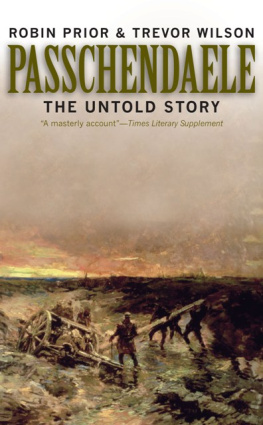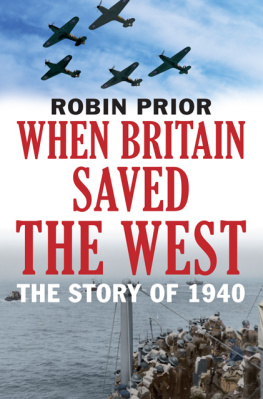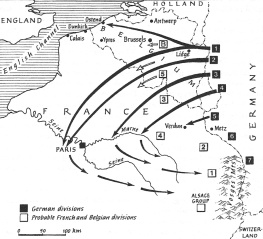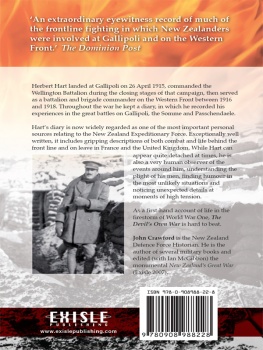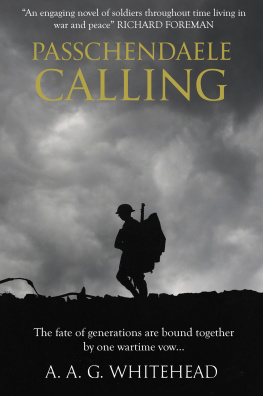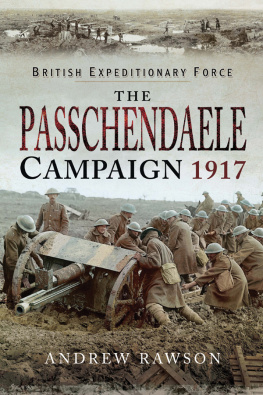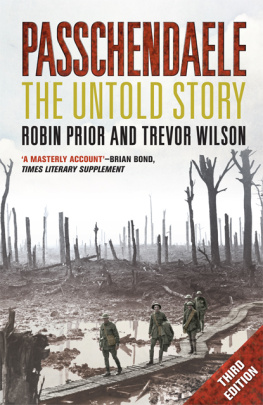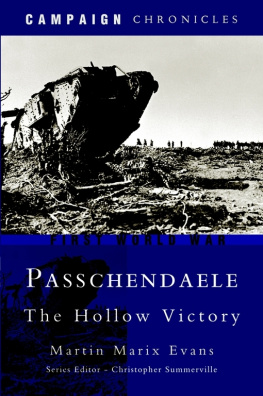Robin Prior - Passchendaele
Here you can read online Robin Prior - Passchendaele full text of the book (entire story) in english for free. Download pdf and epub, get meaning, cover and reviews about this ebook. publisher: Yale University Press, genre: History. Description of the work, (preface) as well as reviews are available. Best literature library LitArk.com created for fans of good reading and offers a wide selection of genres:
Romance novel
Science fiction
Adventure
Detective
Science
History
Home and family
Prose
Art
Politics
Computer
Non-fiction
Religion
Business
Children
Humor
Choose a favorite category and find really read worthwhile books. Enjoy immersion in the world of imagination, feel the emotions of the characters or learn something new for yourself, make an fascinating discovery.
- Book:Passchendaele
- Author:
- Publisher:Yale University Press
- Genre:
- Rating:3 / 5
- Favourites:Add to favourites
- Your mark:
- 60
- 1
- 2
- 3
- 4
- 5
Passchendaele: summary, description and annotation
We offer to read an annotation, description, summary or preface (depends on what the author of the book "Passchendaele" wrote himself). If you haven't found the necessary information about the book — write in the comments, we will try to find it.
Passchendaele — read online for free the complete book (whole text) full work
Below is the text of the book, divided by pages. System saving the place of the last page read, allows you to conveniently read the book "Passchendaele" online for free, without having to search again every time where you left off. Put a bookmark, and you can go to the page where you finished reading at any time.
Font size:
Interval:
Bookmark:

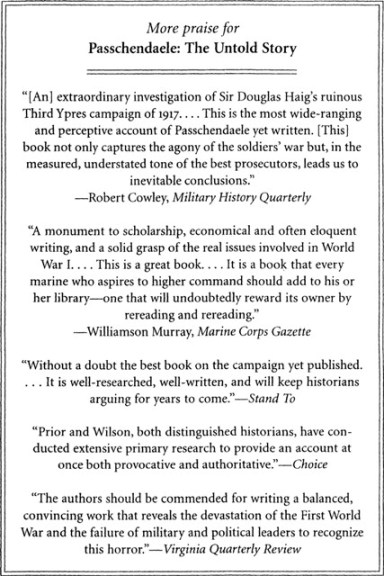



First published as a Yale Nota Bene book in 2002.
Hardcover edition published by Yale University Press in 1996.
Introduction to the second edition copyright 2002 by Robin Prior and Trevor Wilson.
Hardcover editon copyright 1996 by Robin Prior and Trevor Wilson.
All rights reserved. This book may not be reproduced, in whole or in part, including illustrations, in any form (beyond that copying permitted by Sections 107 and 108 of the U.S. Copyright Law and except by reviewers for the public press), without written permission from the publishers.
For information about this and other Yale University Press publications, please contact:
U.S. office
Europe office
Printed and bound in Great Britain by the MPG Books Group
Library of Congress Control Number: 2001098705
ISBN 13: 978-0-300-09307-0 (pbk.)
A catalogue record for this book is available from the British Library.
10 9 8 7 6 5 4
For Heather
and for Ray and Janet
RP
For Nirej
and for Travis
and for Craig
and for young Lucy
Best of friends
TW
Contents
Maps
Acknowledgements
The authors wish to thank their colleagues in the History Departments at the Australian Defence Force Academy and the University of Adelaide for support and encouragement during the preparation of this book. They also wish to acknowledge the assistance of the libraries of those institutions, the Bridges library and the Barr Smith library. For preparation of the maps included here, they owe a profound debt to Keith Mitchell of the Cartography Department, Research School, Australian National University. For preparation of the manuscript, they are grateful to the following: Christine Kendrick, Julie McMahon, Marion Pearce, and Elsa Sellick. For meticulous research in a variety of archives, they wish to acknowledge great assistance from Irene Cassidy in England and from Elizabeth Greenhalgh and Helen Boxall in Australia. The research staff at the following institutions have enabled the authors to make use of their rich and varied archives: the Imperial War Museum, London, Australian War Memorial, the Public Record Office, the Liddell Hart Centre at King's College, London, and the Royal Artillery Institution Library, Woolwich. And for kind permission to reproduce the illustrations, the authors would like to thank the Imperial War Museum, London. Finally, the authors are greatly in the debt of Robert Baldock of Yale University Press for his enthusiasm regarding this project, and to the staff of the London branch of Yale University Press for so expeditiously converting the manuscript into a book.
Introduction to the Second Edition
It is five years since this book was first published. At that point we sought to bring to the attention of readers a number of issues which we considered important for the understanding both of the campaign of 1917 and the essential military characteristics of the entire war.
The first thing we wished to do was to tell, by using material that we considered under-utilized, as complete a story of the military and political aspects of the battle as possible.
Second, we wanted to demonstrate two things. One was that by 1917 the British army had sufficient materiel and expertise to conduct appropriate offensive operations on the Western Front, both employing the weaponry then available and profiting from painful lessons learned in earlier operations. The other was that the leadership-both political and military (if for different reasons)failed to capitalize on these attributes.
In the case of GHQ, the successful operations at Vimy in April 1917 and Messines Ridge in June could have pointed the way forward. On these two occasions British and Dominion troops had demostrated that, if fire support was sufficient and aims limited, key sections of the German defence could be seized and held. To this extent at least some elements of the British army were on a learning curve. Artillerymen, benefiting from longer experience and a range of scientific advances, were now capable of hitting their targets with greater consistency. And lower order commanders now took training seriously, rendering this aspect of soldiering more realistic.
Regrettably the phrase learning curve could not yet be applied to the British high command. And when an action such as that of 14 July failed in its central purpose but produced a bite-and-hold type of success, no conclusions were drawn from this. As for the unrelenting succession of small-scale attacks delivered on the Somme from July to November 1916, these were all regarded as setting the scene for the great decisive blow that would overwhelm the enemy's defensive system, unleash the cavalry, and win the war.
As 1917 dawned, lack of compelling success on the Somme had still not convinced the British command to abandon grand designs and proceed by the methods of bite and hold. Vimy Ridge and Messines were not designed as discrete operations but as overtures to wide-ranging triumphs. So success at Vimy was followed by the slogging match at Arras. And Messines was prelude to the vast blood-letting of Third Ypres. In the course of these major campaigns of 1917, the command consistently spread its fire support over all German defensive positions within range, thereby sparing the enemy front line from the devastating bombardment necessary to take it without heavy loss of life. And the three successful steps across the Gheluvelt Plateau in the Plumer phase of the Passchendaele campaign were not conducted as ends in themselves. They were intended to place Haig's armies in the position from where another unlimited offensive, complete with cavalry, could be launched.
Tragically, the British political leadership was also not interested in the truth proclaimed by the successes at Vimy and Messines. For Lloyd George these operations were of no account. He too wanted a sudden, smashing victory, preferably carried out by non-British troops on a battlefield far distant from the Western Front. But while he sought such a scenario, he sanctioned Passchendaele and so allowed the British army to be diminished by some 200,000 men over a period of only four months.
Third, we wanted in this book to move away from the persistent view that it was the quality of particular infantry divisions or units that determined success or failure. Without wishing to detract from the bravery of the soldiers, it is our view that firepower was the great determinant of success and that the skill of infantrymen, their training, bravery, and endeavour, was bound to count for little in an environment in which hostile machine-guns and artillery shells were allowed to dominate the battlefield. In other words, it was firepower superiority that allowed the soldiers to survive on the battlefield. This might not be a romantic view of warfare. It happened to be the reality of the Western Front.
It follows that our overall portrayal of the Third Ypres campaign depicts a predominantly futile episode of the First World War. The manpower of the British army had been much diminished, and its morale severely damaged, so as to wrest from the enemy a meagre stretch of territory which was voluntarily given up in a few days in response to the German spring offensive in 1918. But, and this is our fourth point, what this book is not saying is that such futile episodes rendered the war as a whole futile.
Next pageFont size:
Interval:
Bookmark:
Similar books «Passchendaele»
Look at similar books to Passchendaele. We have selected literature similar in name and meaning in the hope of providing readers with more options to find new, interesting, not yet read works.
Discussion, reviews of the book Passchendaele and just readers' own opinions. Leave your comments, write what you think about the work, its meaning or the main characters. Specify what exactly you liked and what you didn't like, and why you think so.

